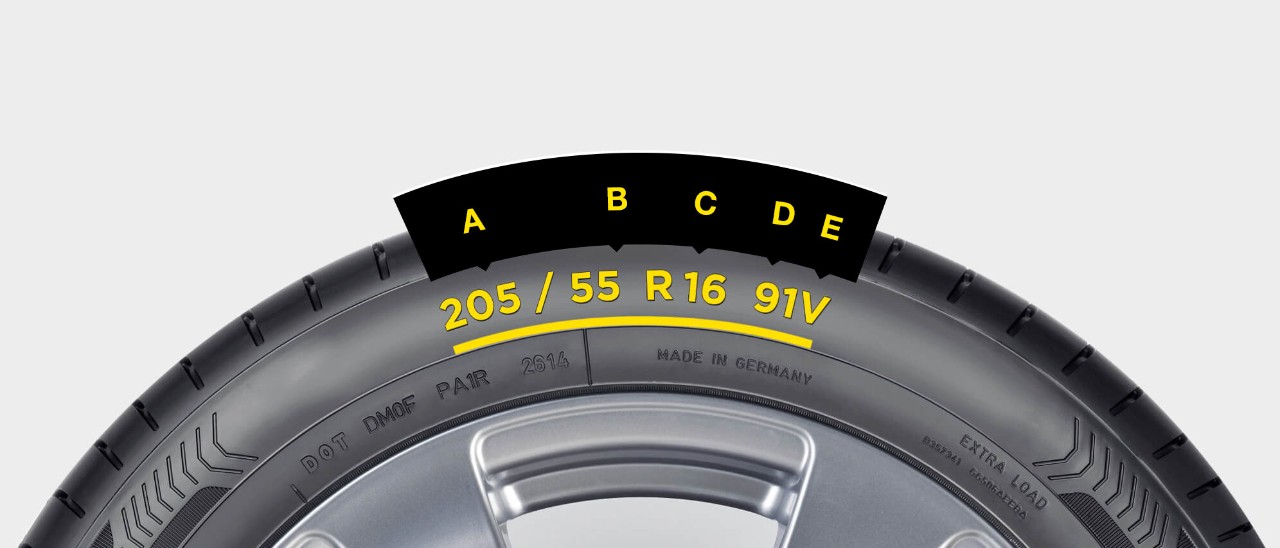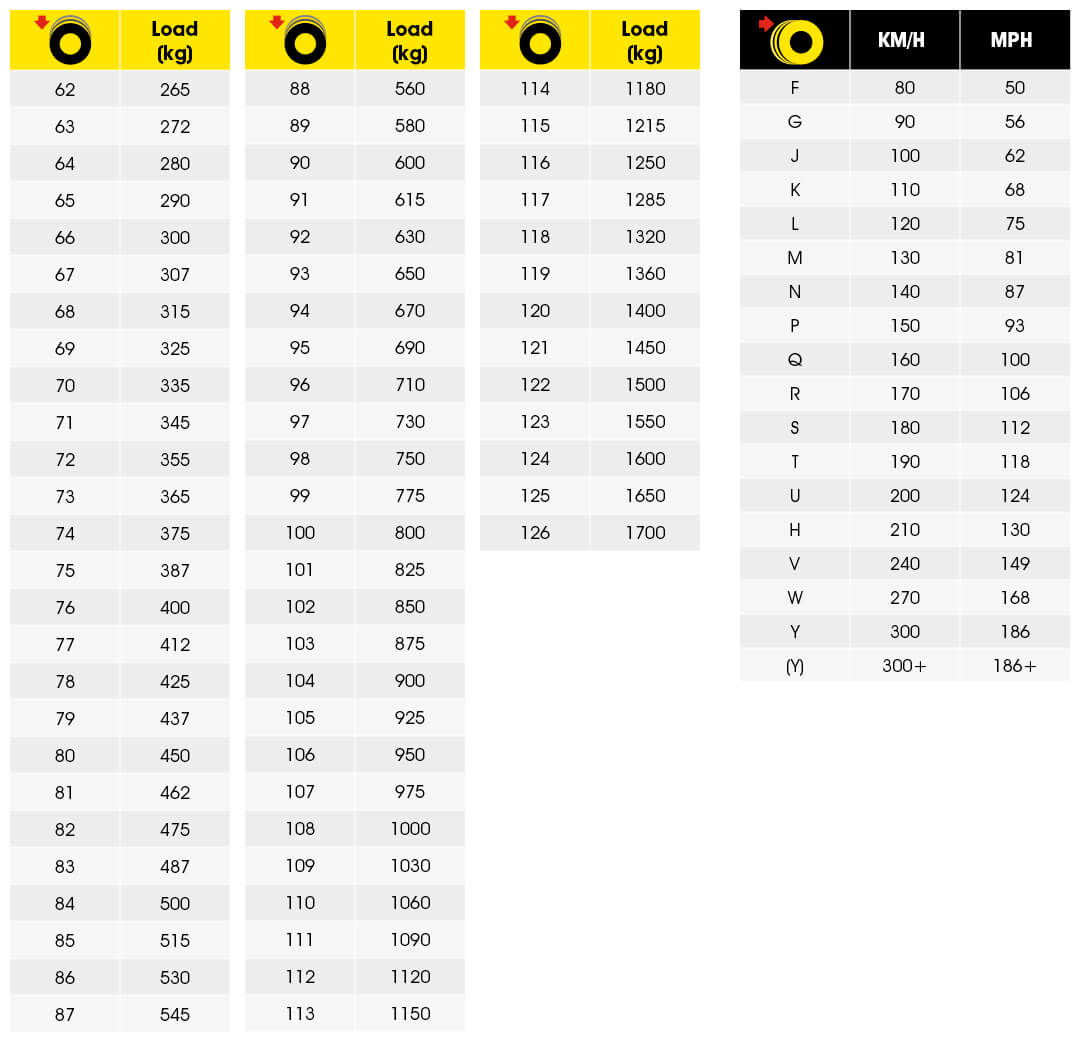You can find tyre markings on the sidewall of your tyre. These sidewall markings help you understand everything you need to know about your tyre including its size, load capacity and speed rating.
The information on your tyre is particularly important when it comes to replacing them, allowing you to easily find the right ones for your car. You can search the Dunlop website for tyres using information from the sidewall markings on your tyre.
But how do you read the sidewall markings? Here’s a little guide to what all those numbers and letters mean:

This measures the width of your tyre from sidewall to sidewall. The measurement is in millimetres (mm).
This is the ratio of the tyre’s cross-section to its width, expressed as a percentage. An aspect ratio of 65, for example, indicates that the tyre’s height is 65% of its width.
This number represents the diameter of the wheel in inches.
Your tyre’s load index appears on your sidewall alongside the speed rating. The load index relates to your tyre’s maximum carrying capacity measured in kilograms (kg).
For example, a tyre with a load index of 91 can carry 615kg of weight. A typical passenger car will have a load index of 75 – 105, with each value corresponding to a weight in kilograms.
Load ratings and speed ratings appear next to each other as they should be looked at together when you buy a new tyre.
When it comes to replacing your tyres, you may be able to put tyres on your car that have a higher load capacity than your manufacturer recommends. However, check first in your vehicle’s manufacturer documentation.
If you overload your vehicle, this will place a stress on critical vehicle components including your tyres. This will cause poor handling, increased fuel consumption and may even cause tyre failure.
The speed rating is the last of the tyre’s sidewall markings, denoted by a letter to the right of the load index number. Each letter represents the maximum speed that tyre can sustain safely under normal conditions.
For example, a tyre with a speed rating of V, has a maximum speed of 240 km/h.
Speed ratings range from A to Z and also depend on your tyres being correctly inflated and being under the weight capacity as per the load index.
When buying new tyres, make sure you match their speed rating with the speed capabilities of your vehicle.
Find the load and speed capacity using the markings on your tyres:

Load Rating
Speed Rating
It may be possible to fit tyres with higher load indexes and different speed ratings to those indicated in your vehicle’s manufacturer documentation.
However, always check first in your vehicle’s manufacturer documentation if these tyres may be mounted on your vehicle and if using these tyres is permitted under your local laws and regulations. You should also comply with all applicable requirements of your local laws and regulations and not exceed the specifications of these tyres as well as those indicated in your vehicle’s manufacturer documentation in terms of speed and load. Your dealer may help you verifying this before purchasing or fitting tyres.
Does the speed rating on a tyre matter?
Yes, a tyre’s speed rating indicates the maximum speed you will safely be able to drive with those tyres in ideal conditions.
Is it possible to fit tyres with a higher speed rating than my manufacturer recommends?
Yes, this may be possible. However, always check first in your vehicle’s manufacturer documentation if these tyres may be fitted on your vehicle.
Is it possible to fit tyres with a higher speed rating and a higher load index than my manufacturer recommends?
Yes, this may be possible. However, always check first in your vehicle’s manufacturer documentation if these tyres may be fitted on your vehicle.
Is it possible to fit tyres with a lower speed rating than my manufacturer recommends?
You can use all-season or winter tyres (marked with M+S on the tyre sidewall) that have a lower speed rating so long as you meet certain conditions:
· A sticker that shows the maximum speed limit is in the driver’s field of vision
· You don’t drive the vehicle faster than the maximum speed limit
However, always check first in your vehicle’s manufacturer documentation if these tyres may be fitted on your vehicle.
Can you have different speed ratings on tyres?
Mixing tyres with different ratings isn’t something we’d recommend. See our guide on replacing tyres for more details on mixing tyres.
Is it possible to fit tyres with a higher load index and a lower speed rating than my manufacturer recommends?
Yes, you can fit tyres that have a higher load index and a lower speed rating.
You can use all-season or winter (M+S) tyres that have a lower speed rating so long as: a) a sticker that shows the maximum speed limit is in the driver’s field of vision and b) you don’t drive the vehicle faster than the maximum speed limit.
However, always check first in your vehicle’s manufacturer documentation if these tyres may be fitted on your vehicle.
Check your vehicle owner's manual to determine the load limits. Overloading your vehicle places stress on your tyres and other critical vehicle components. It can cause poor handling, increased fuel consumption and may cause tyre failure. It can also result in severe cracking, component separation or a "blowout."
There are additional tyre markings that you may see on your tyres, which can provide further information on the tyres.
All Season Tyre Markings
All season or winter tyres are marked with M+S on the tyres. This stands for Mud and Snow and means they have tyre performance capabilities for such conditions. You may also see a mountain and snow symbol, which indicate the tyre is a legal winter tyre.
Tyre type
A “P” or no letter at all indicates a passenger car tyre.
Construction
The letter “R” stands for radial. Almost every new tyre built today is a radial tyre.
OE Markings
An OE marking will indicate whether a tyre is designed to be used on a specific vehicle. A full list of OE markings is displayed below.
Tyre pressure information
This displays the maximum inflation pressure for your tyre. See our guide on tyre pressure for more information.
Tread wear indicators
The letters “TWI” show the location of the tyre’s tread wear indicators. You should check these indicators regularly to ensure there’s enough tread on your tyres. In most EU countries the minimum tread depth 1.6mm.
Production date
This four-digit code tells you the week and year that your tyre was manufactured. For example, 1120 would be week eleven of the year 2020.
ECE approval mark and number
This tells you that the tyre conforms to the standards of the United Nations Economic Commission for Europe (U.N.E.C.E.) in relation to pneumatic tyres.
Original Equipment Manufacturer |
Sidewall marking |
Explanation |
Alfa Romeo |
AR |
Alfa Romeo |
Aston Martin |
AM |
Aston Martin |
Audi |
AO |
Audi Original |
Bentley |
B |
Bentley |
BMW |
* |
“Star” marking |
BMW & Mercedes |
* MO(E) |
"Star" marking & Mercedes Original (Extended) |
Ferrari |
K1, K2, K3 |
/ |
Jaguar |
J |
Jaguar |
Lamborghini |
L |
Lamborghini |
Land Rover |
LR |
Land Rover |
Jaguar & Land Rover |
JLR |
Jaguar Land Rover |
Lotus |
LS |
Lotus Exige S |
Maserati |
MGT |
Maserati Genuine Tires |
Maserati & Jaguar |
MGT J |
Maserati Genuine Tires & Jaguar |
McLaren |
MC |
Mclaren |
Mercedes |
MOE |
Mercedes Original Extended (ROF) |
Nissan |
NR1 |
Nissan GT-R Nismo |
Porsche |
N0, N1, N2, N3, N4, N5, N6 |
|
Tesla |
T0, T1, T2,… |
Tesla Original |
Volvo |
VOL |
Volvo |